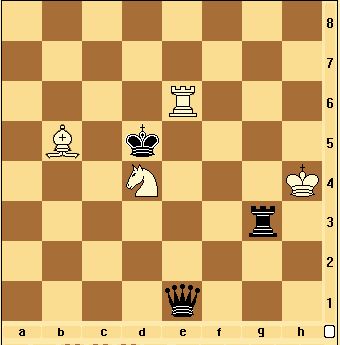I had made some observations which turned out to be correct, and which I give to the reader to help him find the solution.
** If the wK reaches the e4 square the Ws win because they will "classically" lead their P to d7 with wK d6 and bK d8, the Bs will have to play a6 or a5 and the Ws will mate after the promotion to D/T at a8.
** If the W's try to get their K to e4 as soon as possible, the B's have the following defence plan:
1:Kb1/b2/b3 Kd6/d7 2:Kc2/c3 Kc7 3:Kd3 Kb7 4:d5 a5! (draw) 5:ba Ka6 6:Ke4 b5 7:Ke5 b4 8:d6 Kb7! 9:Ke6 b3 =
So B has a draw manoeuvre by a5 when W has Ke4 and Pd4. But then: what can W's do with this manoeuvre?
** When the bK is on c7, the W's must be able to play Kc4 in order to answer Kb7 with Kd5!
** If the wK is on d3, the Bs draw by playing Kd5
If the wK is on c4, the Bs draw by answering Ke6 (be careful, the side to move is important).
If the wK is on c3, the Bs draw by answering Kd6! because then they can answer Kd3 with Kd5 and Kd2 with Kc7! as already seen.
** Don't let the bK come to c4 unthinkingly.
There, I had found that, now I had to find the solution.
Then comes the study of the day.
If I had this position in the game, I would obviously not be reassured. However, if you have to play, with the W's it's quite easy because you just have to play each time the move that doesn't lose immediately. So the study is quite easy and humanly very accessible, but the difficulty is to consider the strongest black moves.
So without revealing everything, I advise to consider in first B move (after the key) the Queen moves of the rectangle defined by the diagonal b7-c5.
I don't know if the Master planned to broadcast the exercise given for the next lesson (WHICH WILL TAKE PLACE NEXT TUESDAY) or if he thought to reserve it to the only audience present. So here it is
:
1.d4 Nf6 2.c4 e6 3.Nf3 d5 4.Nc3 dxc4 5.e4 Bb4 6.Bg5 [if one does not know, one can also play 6.e5 Nd5 7.Bd2]
6...c5 7.Bxc4 cxd4 8.Nxd4 Bxc3+ 9.bxc3 Qa5 10.Nb5
[The old variation was 10.Bxf6 Qxc3+ 11.Kf1! Qxc4+ (11...gxf6 12.Rc1!) 12.Kg1! Nd7 13.Bxg7 Rg8 14.Rc1 Qa6 15.a4! with the idea of Nb5 as in the old days they already knew how to laugh]
10...Bd7 A theoretical novelty of Timman, which must have surprised Karpov.
Until now the known moves were 10:. Ne4 and 10:... a6. Let's mention in passing 10...a6 11.Nd6+ Ke7 12.Qd2 Nc6 13.Rd1 Rd8 14.0-0 Qc5 15.e5 Qxe5 16.Bf4 Qc5 17.Qb2 b5 18.Be3 Qe5 19.Qa3 Ng4 and the game was of course a draw, which will surprise no one since the B's were held by Trifunovic, who is known as the king of draws. ("Ha, mais lis!") Note however that W here avoided the formidable trap 20.Nxc8+? Kf6! 21.Bg5+ Kg6!! and win
11.Nd6+ Ke7 12.Qd2 Bc6 13.f4 Nbd7 14.Rd1! (threatens 0-0) 14...Rhd8 15.Qd4 [Threatening e5 again which is momentarily prevented 15.e5? Nxe5!]
15...h6 16.Bh4 Qh5! 17.Bf2 Kf8 18.e5 Nd5 19.0-0 Qg4?! The threat was Rd3-Rh3. The idea of this move is therefore to parry the threat by attacking f4 and thus forcing g3.
Note that, although W's are better, Nd7-b6 held.
20.h3! the bad surprise because if 20...Qxf4? 21.Bxd5! Qxd4 22.Bxd4 Bxd5 23.Rxf7.
20...Qh5 21.f5+- Kg8 22.Rd3 [Let us signal here the formidable efficiency of the computer which indicates 22.Bh4! Rf8 23.Rd2! with the threat Be2]
22...N7b6 23.Bxd5 Karpov gratifies this move with a "!" which is understandable because it initiates a human strategic conception of invasion on the B-squares.
The computer indicates 23.Bb3 with the threats Bd1 and Bh4 or Rg3 and Bd1 which is very respectable.
23...Bxd5 [23...Nxd5 offered better resistance]
24.Rg3 Rd7 25.Be3 (threatening Rf4-h4)
25...Bc4 26.Rf4 f6 27.exf6 e5 28.Qxe5 Qd1 29.Kh2 Qxd6 30.f7+! Kxf7 31.Qxg7+ Ke8 32.Qh8+ Ke7 33.Re4+ 1-0
Finally, to end the evening, we found ourselves at dinner very late.
This explains why, after Guy had graced us with his presence for the aperitif, I found myself alone with the master to look for the fairy lights, which, in view of my efficiency, ended up being one, as follows.

h#2, 2 solutions, Immune Chess
(i.e. a piece can only be captured if its circe rebirth square is free. For example, if the B's play Qg1, they cannot play Kxd4).
Easy but very clean and nice problem by the pair Pierre Tritten, Jacques Rotenberg.
Here at last is the Master's account, available from 2.30 am on Wednesday morning : it's magic, how does he do it ?
Add a comment